#uv pigment
Text
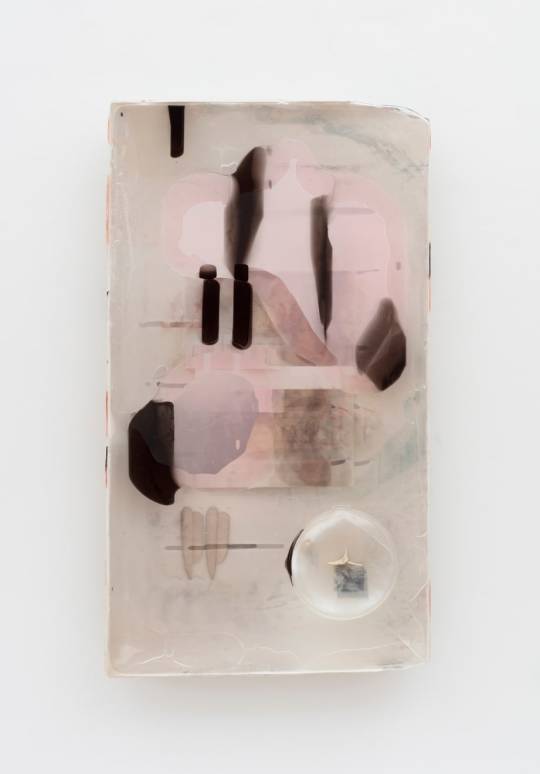
Josh Tonsfeldt
Untitled
2022
Fiberglass reinforced gypsum, fiberglass cloth, epoxy resin, pigments, inkjet dyes, UV cured pigment print, silver gelatin print, dye sublimation print on polyester bed sheet, wood, bone, television components
27.75 x 49.25 x 3.25 in.
#Josh Tonsfeldt#sculpture#fiberglass reinforced gypsum#fiberglass cloth#epoxy resin#pigments#inkjet dyes#UV cured pigment print#silver gelatin print#dye sublimation#print#polyester bed sheet#wood#bone#television components#beige#pink
135 notes
·
View notes
Text



This hoe is solid as Fuck.
'Turn-A Gundam'
Painted all stickers, instead, except for the eyes; for a cleaner look
Fun chance to use my new uv reactive paint on this plumber looking mother fucker. I'm excited to use them on more in the future :3
"respect the 'stache!!"
#gundam#gunpla#plamo#gun plastic#model kit#posing#mecha#anime#manga#robot#robots#turn a gundam#turn a#i painted some UV reactive pigment into the v :3#gunevo#gundam evolution
144 notes
·
View notes
Text

UV Pigments, I can’t wait to make things with them!
#arty#artwork#my art#oddsockzx#art#artists on tumblr#artist#pigment#resin creations#resin#neon yellow#neonvibes#neon green#neon pink#neon art#nail art#uv#uv art#uv light
25 notes
·
View notes
Text
can you imagine how fucked up the makeup industry would be if humans could see UV light. buying two different foundations to match your stripes. people painting new stripe patterns on themselves
#humans have stripes under UV if you didnt know. theyre called blaschko's lines#also if u dont know foundation isnt like inherently for covering up shit... a lot of powdered pigments dont stick to bare skin very well#you need some kind of primer first#just like actual paints lol
3 notes
·
View notes
Text
My stamen brings all the bees to the yard

#jokes#bees#flowers#puns#stamen might not be accurate actually#what about flowers does attract bees? is it secret UV patterns like I’ve heard?#my pigments bring all the bees to the yard#originally this was “my pistil brings all the bees to the yard” but I would guess fewer people know that word. idk.#am not a botanist#don’t come at me#some hot sexy flower action
2 notes
·
View notes
Text
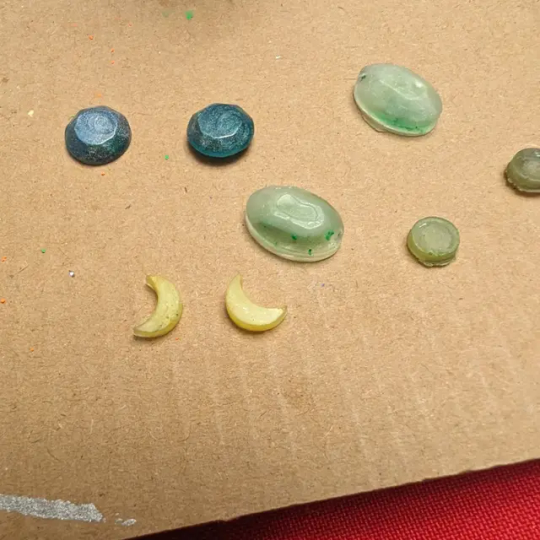
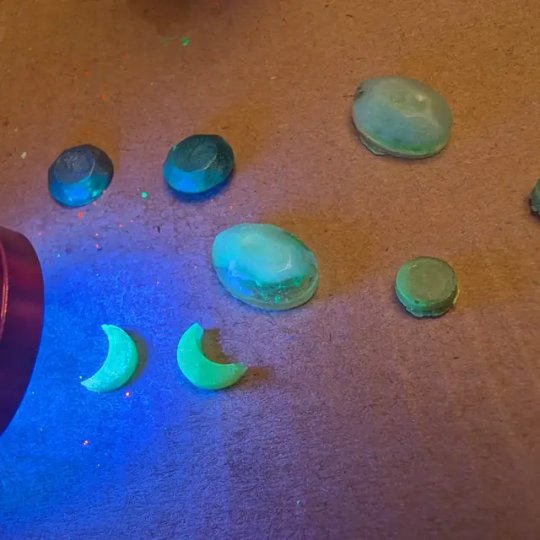
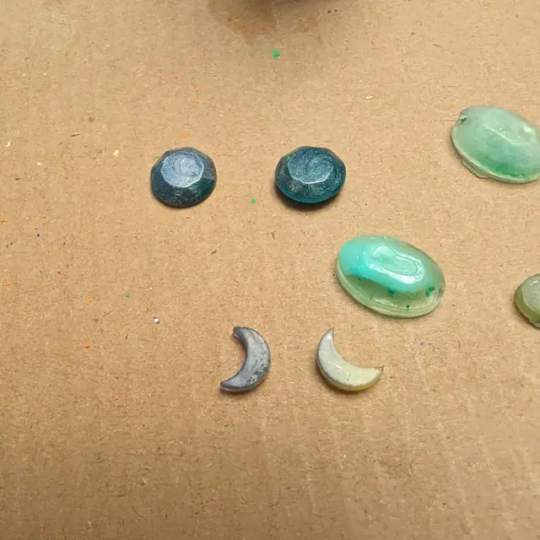
Got me some more cool pigments from Stuart Semple! Holographic glitter (in the big circles, it didn't photograph well), Lit, and "Untitled-Variant". That's in the moons: starts off a cheery yellow, but when exposed to UV it not only reacts as neon yellow in the dark, it changes to a deep blue! AND it glows in the dark! Dope as hell, can't wait to make ALL the shit with this. It's a pity I don't have dice molds...
#gg ramble#diy gone awry#uv resin#stuart semple#culture hustle#glow in the dark#blacklight#i also got some really pigmented blacklight pigments from a local craft store#and when i showed all this to my mom she literally went 👀#i get my love of glowy things from her and now she is thinking of ways to use this too
3 notes
·
View notes
Text
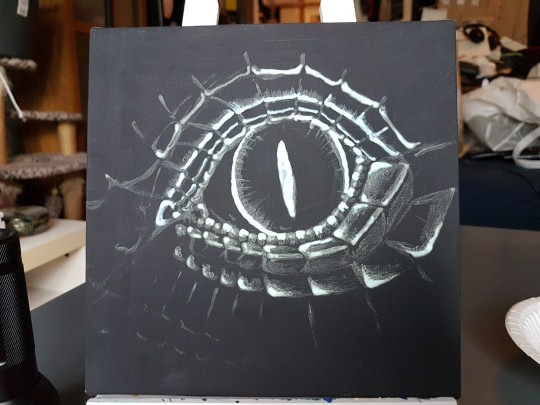
Had some paint I've been meaning to use for a while and it looks pretty good even if it's a bit difficuilt to work with considering it's just regular paint-

PSYCHE ITS GLOW IN THE DARK
#posting now bc im gonna let it dry for a bit and continue later tonight or tomorrow#traditional art#krig arts#its very hard to get it even bc unlike normal paint the particles arent a fine pigment#fun tho! havent done art in a while :3#also if youre wondering how i can capture the glow on a mediocre phone camera#its bc i have a uv flashlight
6 notes
·
View notes
Text
PURE SWEET ORANGE ESSENTIAL OIL
It detoxifies the skin and eliminates all microorganisms. Its presence of antioxidants inhibits the action of oxidation, dark pigmentation, blemishes, and marks. This provides the skin with a healthy shine and reduces the appearance of marks. It helps to minimize skin discoloration and dullness. Organic Sweet Orange Essential Oil is high in antioxidants, which bind to free radicals and inhibit their action. This minimizes fine lines, laughter lines, and wrinkles. It also repairs the damage caused by damaging UV rays, which promote premature aging and dulling of the skin. It possesses anti-bacterial and anti-inflammatory properties that help heal the scalp and prevent dandruff. It deeply nourishes the scalp and promotes hair development.
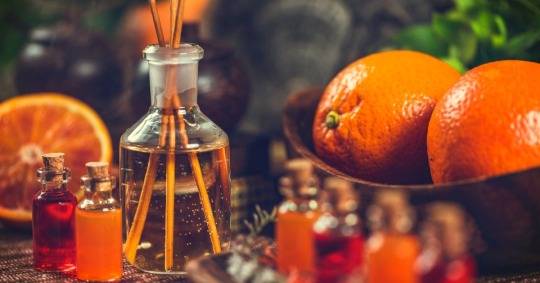
#uv rays#hair development#essential oils#usda certified#anti bacterial#anti inflammatory#fine line#skin discoloration#dark pigmentation
0 notes
Text
Treatment and Prevention of Sun Damage and Pigmentation
Our skin is a canvas that tells the story of our lives, but sometimes, unwanted elements like sun damage and pigmentation can cloud its radiance. In this guide, we will explore the world of skincare, unveiling effective treatments and preventive measures that can help you achieve that coveted radiant complexion.
Understanding the Impact of Sun Damage and Pigmentation
The Sun's Role in Skin Damage: While the sun is a source of life, its ultraviolet (UV) rays can wreak havoc on our skin. Prolonged exposure to these rays can lead to a range of issues, from premature aging to skin cancer.
The Science Behind Pigmentation Issues: Pigmentation is a result of the uneven distribution of melanin, the pigment responsible for skin color. Sun exposure triggers melanin production, leading to dark spots, freckles, and uneven skin tone.
Recognizing the Signs of Sun Damage: Fine lines, wrinkles, sunspots, and a leathery texture are telltale signs of sun damage. Understanding these indicators can help you take timely action.
Premature Aging: Sun damage is a major contributor to premature aging of the skin. It can lead to the development of fine lines, wrinkles, and sagging skin. Ultraviolet (UV) radiation from the sun breaks down collagen and elastin fibers in the skin, which are responsible for its elasticity and firmness.
Skin Cancer: Perhaps the most serious impact of sun damage is an increased risk of skin cancer. UV radiation from the sun can damage the DNA in skin cells, leading to mutations that can result in skin cancer. There are different types of skin cancer, including basal cell carcinoma, squamous cell carcinoma, and melanoma, with melanoma being the most deadly.
Actinic Keratosis: These are rough, scaly patches that can develop on sun-exposed areas of the skin. While they are usually considered precancerous rather than cancerous themselves, they can sometimes progress to squamous cell carcinoma if left untreated.
Eye Damage: Sun damage isn't limited to the skin. Prolonged exposure to UV rays can also harm the eyes, leading to conditions such as cataracts and macular degeneration.
Reduced Skin Elasticity: The breakdown of collagen and elastin fibers in the skin due to sun exposure can result in a loss of skin elasticity. This can cause the skin to sag and appear less youthful.
Increased Risk of Allergic Reactions: Sun-damaged skin may become more sensitive and prone to allergic reactions, including rashes and hives.
Tailored Skincare Regimen for Sun Damage and Pigmentation
Cleansing: Cleanse your skin twice daily to remove dirt, excess oil, and impurities. Use a gentle cleanser to avoid stripping your skin of its natural oils.
Exfoliation: Regular exfoliation helps remove dead skin cells, allowing fresh and healthy skin to emerge. Choose exfoliants with alpha hydroxy acids (AHAs) or beta hydroxy acids (BHAs) for effective results.
Nourishing with Antioxidants and Vitamin C: Antioxidants like vitamin C help combat free radicals caused by sun exposure. Incorporating serums and moisturizers rich in these nutrients can aid in reducing oxidative stress.
Advanced Treatment Options for Sun Damage and Pigmentation
Chemical Peels: Chemical peels involve the application of a solution to remove the damaged outer layers of skin. This reveals a smoother and more even complexion underneath.
Laser Therapy: Laser treatments target specific pigmented areas, breaking down excess melanin and promoting collagen production for rejuvenated skin.
Microdermabrasion: This procedure involves gentle exfoliation using a diamond-tipped wand, effectively removing dead skin cells and promoting cell turnover.
Holistic Approaches to Sun Damage and Pigmentation Prevention
Internal Hydration: Adequate water intake keeps your skin hydrated from the inside out, promoting elasticity and a healthy glow.
Diet Choices: Incorporate foods rich in antioxidants, vitamins, and minerals. Colorful fruits and vegetables, as well as foods high in omega-3 fatty acids, contribute to skin health.
Lifestyle Changes: Minimize sun exposure during peak hours, and whenever possible, wear protective clothing, sunglasses, and wide-brimmed hats.
Protecting Your Skin Daily from Sun Damage
Importance of Broad-Spectrum Sunscreen: Sunscreen is your shield against UV rays. Opt for a broad-spectrum sunscreen with at least SPF 30 and apply it generously to all exposed areas.
Sunscreen Application Techniques: Apply sunscreen 15-30 minutes before sun exposure and reapply every two hours. Don't forget overlooked areas like your ears and the back of your neck.
Reapplication: Key to Long-lasting Protection: Swimming, sweating, and towel-drying can reduce sunscreen effectiveness. Reapply after these activities to ensure continuous protection.
Targeted Ingredients for Pigmentation Correction
Retinoids: Derived from vitamin A, retinoids encourage skin cell turnover, fade dark spots, and improve overall texture.
Niacinamide: Also known as vitamin B3, niacinamide helps reduce the appearance of pigmentation by inhibiting the transfer of melanin to skin cells.
Alpha Arbutin: This natural ingredient inhibits melanin production, making it effective in treating and preventing hyperpigmentation.
Professional Consultation and Expert Advice
Dermatologist's Role in Treating Sun Damage: A dermatologist can assess the extent of your sun damage and recommend personalized treatment plans.
Customized Treatment Plans: Everyone's skin is unique. A professional can create a tailored regimen that addresses your specific concerns and goals.
Regular Check-ups for Progress Tracking: Visiting a dermatologist regularly allows you to track your skin's progress and make necessary adjustments to your skincare routine.
Conclusion: Radiate Confidence with a Healthy, Protected, and Even-Toned Complexion Your journey to radiant skin begins with understanding the factors contributing to sun damage and pigmentation. By adopting a comprehensive skincare routine, staying vigilant with sun protection, and seeking expert guidance, you can achieve a complexion that exudes health and radiance. Remember, your skin is a reflection of the care and attention you invest
0 notes
Text
Die natürliche Maserung betonen

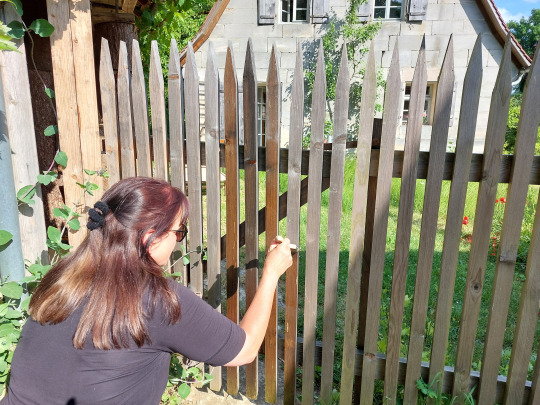
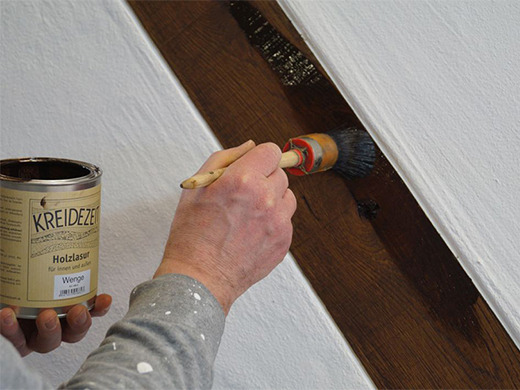
Lasuren in Holzfarbtönen kommen ohne synthetische Zusätze aus / UV-Schutz mit Erd- und Mineralpigmenten
Ob Holzverkleidungen, Gartenhaus, Pergola, Fensterläden, Zaun, Balkon oder Fachwerk: Holz im Außenbereich braucht einen Schutz vor Wind und Wetter.
Transparente Lasuren auf Leinölbasis schützen das Holz vor frühzeitiger Alterung, Abwitterung und Verfärbungen. Sie betonen – anders als deckende Anstriche - die natürliche Struktur des Holzes. Für den nötigen UV-Schutz sorgen Erd- und Mineralpigmente. Je nach Mischung lassen sich mit ihnen passende Farbtöne für alle gängigen Hölzer erzielen. Farblose Lasuren dagegen benötigen synthetische Substanzen, um vor UV-Licht zu schützen.
Lasuren von Naturfarbenherstellern wie Kreidezeit bestehen aus biologisch unbedenklichen Stoffen wie Lein- und Standöle und sind frei von Bioziden. Als natürliches Lösemittel fungiert Balsamterpentinöl, das aus dem Harzausfluss (Balsam) von Kiefern extrahiert wird.
Die Leinöl-Moleküle der Lasuren dringen tief ins Holz ein und füllen sämtliche Poren. Es entsteht eine wetterfeste Imprägnierung, die trotzdem dampfoffen ist. So kann sich keine Feuchtigkeit im Holz sammeln und es kann nicht faulen. Im Gegensatz zu Kunstharz-Anstrichen platzen diese Lasuren nicht ab, reißen und blättern nicht, sondern wittern allmählich gleichmäßig ab und lassen sich einfach renovieren. Es genügt, die lasierten Hölzer nach einigen Jahren zu reinigen und den Anstrich zu erneuern. Lästiges Abschleifen wie bei beschädigten Kunstharzanstrichen entfällt.
Die Lasuren sollten am besten mit einem Pinsel aufgetragen werden. So lassen sich Überlappungen besser vermeiden als mit einer Rolle.
Weitere Informationen unter www.biobaunetz.de
#Kreidezeit#Lasuren#Holzfarbe#Leinöl#ökologisch#UV-Schutz#Wetterschutz#Pigmente#garten#gartenzaun#farbton
0 notes
Text
Scientists are very serious.
This is a post about science. And soup.
Dr. Elinne Becket, a microbiologist from Cal State University, is in the middle of one of those Fridge Experiments that happens to us all - except in this case, she is uniquely placed to unravel the science down to the microbial level.
While cleaning out her fridge, Dr. Becket found that a tub of family-recipe beef vegetable soup had turned bright blue. “Ok I'm outing myself here,” she tweeted, “but there was forgotten beef soup in our fridge we just cleaned it out and it was BLUE?!?!? Wtf contam would make it blue??? Like BRIGHT blue!! Even w/ all my years in micro I'm not handling this well.“
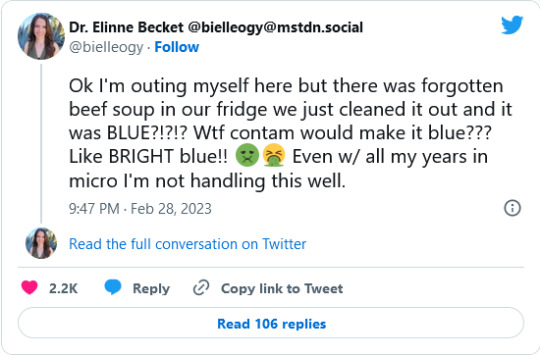
Read on for a breathless and ongoing saga of Soup and Science, and the wonderful international community that is Academic Twitter.
Academic Twitter quickly reminded her of her Responsibilities to Scientific Inquiry. (Cue the chanting from around the world of “CLONE THE SOUP! CLONE THE SOUP!”)
“I can’t believe y’all talked me into going back into the trash.” she tweeted in response, over a photo of a puddle of beautiful Mediterranean-sea blue soup in the trash bin, with bits of veg and noodles arising from the depths.

Scientists being scientists, Dr. Becket agreed to take a sample and send it to colleagues for cloning and microbial analysis.This involved getting arms-deep into the trash bin of Old Soup. “I’m never forviging @ATinyGreenCell (genomic biologist Sebastian Cocioba) for this.” Dr. Becket tweeted, with a photo of a properly dipped and snipped and VERY blue q-tip in a small clear plastic tub.

Diving into decomposing soup was not the only hazard. She writes: “My mom (who made the soup for my birthday) came across this thread and now 1) I have to answer for letting her soup spoil and 2) she's worried @ATinyGreenCell will figure out her secret recipe.“
Dr. Becket and Sebastian were able to culture the Blue Goo!
Becket posted a photo of three petri plates of streaked beef bouillon agar at 72 hours incubation, at 37C, room temp and 4C. She writes: “Left the plates where they were for another 2 days, except the 37°C one was brought to RT, which then grew white stuff over the yellow stuff and stinks to high heaven. RT looked the same. 4°C had impressive growth. Restreaked them all onto TECH agar, awaiting results!”

Sebastian, from his lab, tweeted a photo of three more covered petri dishes, with early results: “Great progress on isolating the glowy microbe from our #BlueSoup! It's so fluorescent the streak is GREEN. Still needs another restreak as it seems there is a straggler but should clear up in the next plate. Exciting!”
Then yesterday, Sebastian tweeted out an updated photo of his plates under daylight and blacklight. “Whatever grew on the #BlueSoup colony plates overnight glows under UV, but only on King's Agar B! That particular media is used to tease out fluorescein expression in pseudomonads. What are the chances that the same cell line expresses fluorescent AND blue pigments?“

“Looking closer, there definitely is a handful of different microbes showing distinct phenotypes. Could be that the blue producer and the fluorescent microbes are totally different microbes!”
At which point, Professor Cynthia Whitchurch of Norwich, England, responded: “Consistent with P. fluorescens being at least part of the #BlueSoup community. The fluorescence is due to production of the siderophore pyoverdine which is up-regulated when iron availability is limited. P. aeruginosa produced this too but my guess is you have blue Pf.”
And Australian agricultural researcher @WAJWebster helpfully tweeted a petri dish of ALL KINDS of colourful bacterial colonies from white to yellow to orange to stark black, with a cheerful: “You need bact-o--colours? I got you, fam.”
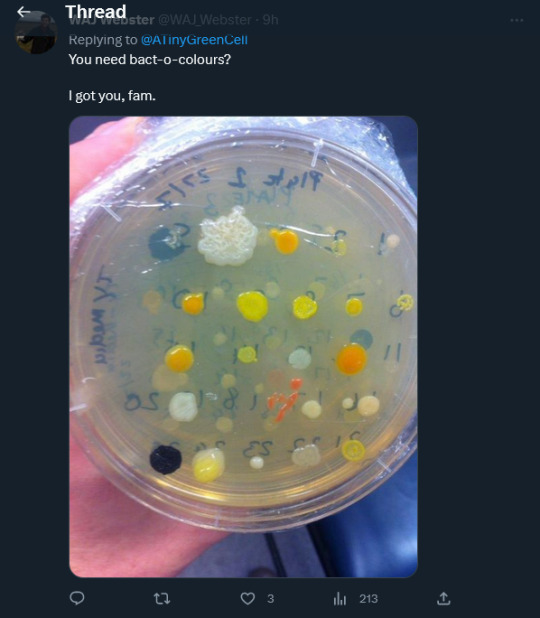
The best part is that as of today, March 9, 2023, THE BLUE SOUP MYSTERY CONTINUES. WE ARE WATCHING SCIENCE HAPPENING!
A paper is being written. And Dr. Becket’s mum is getting an author credit as the proprietary owner of the #BlueSoup recipe.

Dr. Becket’s Twitter is here: https://twitter.com/bielleogy
Sebastian Cocioba’s Twitter is here: https://twitter.com/ATinyGreenCell
Fun IFLS story is here: https://www.iflscience.com/microbiologist-investigates-after-her-beef-soup-turned-blue-in-the-freezer-67894?fbclid=IwAR0H27KqVZhzzrosnjzzKkxuKASZ-0L0Lt6hGwCRDJK8xvFbbSlyS4JvwlM
15K notes
·
View notes
Text
Enhance Product Value and Drive Innovation with Xiamen Magic Color Technology Co., Ltd's Unique Color Change Pigments
Are you looking for innovative ways to add value to your products and set yourself apart in the market? Look no further! Introducing Xiamen Magic Color Technology Co., Ltd, a pioneering company specializing in color change pigments that can help you elevate your products and boost innovation in your industry.
We offer an extensive range of cutting-edge color change pigments,…

View On WordPress
#colorchangepigment#glow in the dark#hydrochromic ink#Optically variable pigment#Photochromic pigment#Reflective powder#Thermochromic pigment#UV invisible fluorescent pigment
0 notes
Text
Betty Fiske & Linda Stribermorenus, 2004, Ultraviolet and Infrared Examination
of Japanese Woodblock Prints: Identifying Reds and Blues, BPG Annual
0 notes
Text
1 note
·
View note
Text
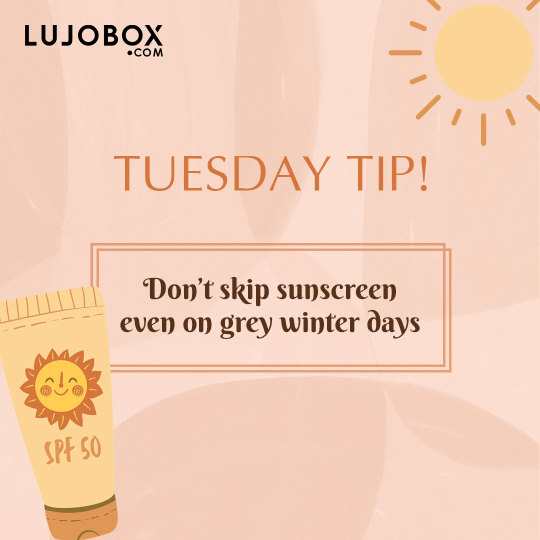
Wear sunscreen every day even in those cold, not-so-sunny winter months. No matter how cold or cloudy if is , the UV rays from the sun can always reach us and damage the skin .
#sunscreen#sunscreeneveryday#spf#sunscreenspray#sunscreencream#sunstick#skincarecommunity#skincareroutine#vitaminc#postinflammatoryhyperpigmentation#beautytips#sunprotection#sunblockspf50#pigmentation#spf50#sunscreens#uv#sunscreenspf30#skincare#skincaretips#monthlysubscription#beautybox#lujobox#lujoboxbeauty#sunscreenalways#uvrays#uvprotection#skincareaddict
0 notes
Text
Shop Now!! Dr. Sheth's Sunscreen SPF 50 Cream with Ceramide & Vitamin C
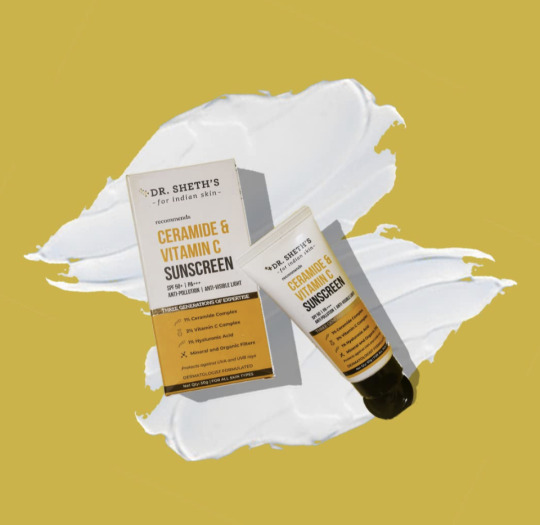
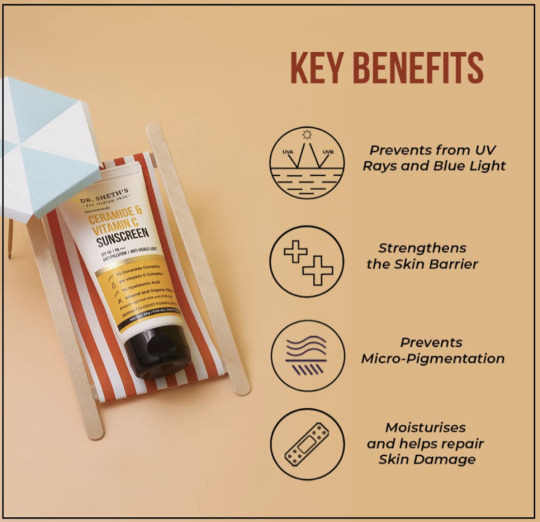
#sunscreen#aesthetic#explore#foryou#my fyp#explore page#fypage#shop now#shopping#fashion#amazon#antiaging#skin care#beauty tips#skincareproducts#sunnyday#sun protection#uv light#skin barrier#pigmentation#repair#brown skin#skin treatment#moisturizer#moisturizing#acne#ceramides#vitamin c#antioxidants#vitamins
0 notes